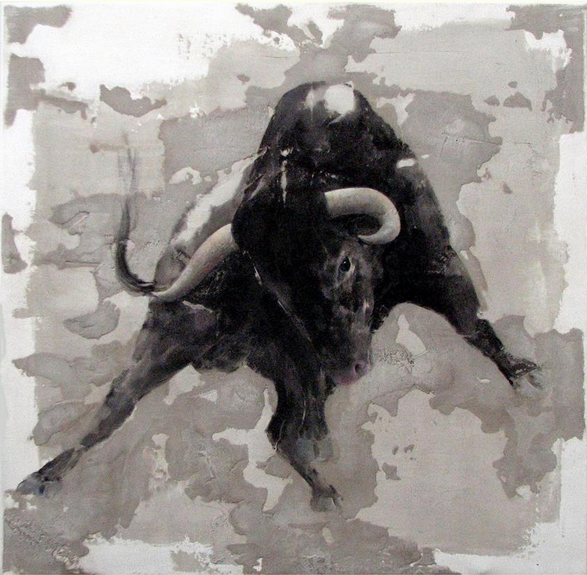JAN GROTENBREG
SCHILDERIJEN
BIOGRAFIE
Jan Grotenbreg werd in de Noord-Hollandse stad Alkmaar geboren en volgde de Academie voor Beeldende Vorming in Tilburg.
Sinds 1967 woont en werkt hij in Amsterdam op de hoogste verdieping van een atelierwoning, dat in de dertiger jaren speciaal ontworpen werd voor kunstenaars. Vanuit deze studio heeft hij een formidabel uitzicht op de unieke Hollandse wolkenluchten, die hem altijd inspiratie gegeven hebben: "De veranderlijkheid, ongrijpbaarheid en vanzelfsprekendheid van wolken zijn, tezamen met de schitterende grijze tinten, enorm fascinerend. Elke wolkformatie heeft één briljant moment en als ik een interessante wolkenpartij zie raak ik in paniek, ik moet aan het werk, dat is de prijs voor deze verhouding", aldus Grotenbreg in een interview.
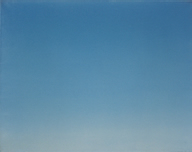
In 1970 besloot Grotenbreg om een monochroom blauw vlak te schilderen. Binnen de begrenzing van het formaat wilde hij de "totale ruimte" uitdrukken.
Vanuit dit perspectief begon hij met het schilderen van wolkenluchten, waarbij de horizon is verdwenen. Men kan deze serie zien als een vervolg op de oer Hollandse landschapsschilders traditie. Grotenbreg's wolken worden gezien als 'machtige evocaties van de ervaring om op je rug te liggen kauwend op een grasspriet en starend naar het eindeloze, steeds wisselende, trage, theatrale spel der wolken' (criticus Ferd Op de Coul).
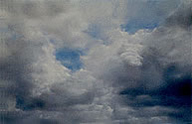
Zijn schilderijen maakten deel uit van moderne kunsthistorische stromingen als Fundamentele Schilderkunst (de identiteit van het medium: het vlak, de verf en textuur zijn belangrijker dan de voorstelling) en Hyperrealisme (waarin een voorstelling scherper is verbeeld vergeleken bij een foto). Ook Grotenbreg gebruikt fotografie als middel.
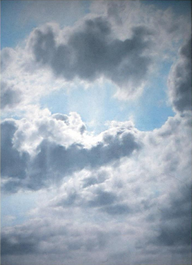
In 1996 schilderde Grotenbreg een indigoblauw vlak, de hemel. Een zilverglanzende volle maan verscheen in het nachtlicht, in een geheimzinnige, occulte atmosfeer. Daarna maakte hij een serie Maanlandschappen en Manen en Nachtlicht (deze serie ontstond tijdens een reis langs dorpen in Frankrijk, waar de straatverlichting 's nachts uit ging). Op een zeker moment verscheen er ook een hond, als 'waakhond' tussen ondermaans en bovenmaans. In deze serie werken wordt het mystieke aspect in zijn werk voelbaar.
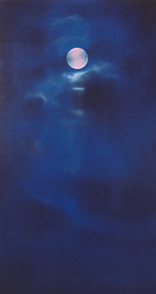
In 2000 voegde Grotenbreg een nieuwe (meer aardse) dimensie aan zijn werk toe, toen hij begon te experimenteren met cement op linnen als ruwe ondergrond voor een voorstelling. Op deze manier maakte hij het schilderij 'Halve Maan' met een lijst van cement. Het resultaat is vaak vergeleken met middeleeuwse muurschilderingen, de zo-genoemde fresco, geschilderd in natte kalk.
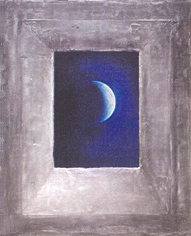
Deze techniek was in Europa (met name in Italie) een wijdverbreide decoratieve kunstvorm, waar de verweerde stukken van zijn overgebleven. Grotenbreg is echter niet zo geïnteresseerd in de decoraties, maar meer in de verweerde kwaliteit ervan. Dit vormt het uitgangspunt voor een indrukwekkende reeks dierenstudies naar de natuur.
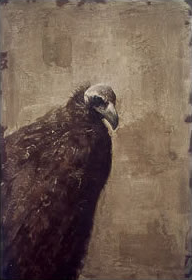
Veel dieren zoals het paard, de koe en de stier, alsmede minder bekende dieren zoals de beschermde roofvogel de monnikskapgier, de Egyptische Nijlvogel Ibis en de bedreigde huismus zijn door Grotenbreg in een laag grijs cement met acryl verf in zwartbruine kleurnuances op linnen vastgelegd. Hij schildert enkel dieren waar hij een bepaalde affiniteit mee heeft. (Met name de ibis - de Ibis als God, de heilige vogel in het oude Egypte - inspireert hem; hij maakte verschillende reizen naar Egypte).

Grotenbreg over de techniek: "De onderlaag met cement is uniek, de techniek is niet gangbaar. Cement is een bouwstof en houdt niet op doek. Na veel experimenten heb ik met moderne bindmiddelen een oplossing voor dit probleem gevonden. De textuur en compositie van het op te brengen cement is een belangrijk onderdeel in mijn werk, waarbij ervaring de leermeester is.
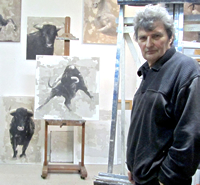
Jan Grotenbreg heeft in eigen beheer verscheidene boeken over zijn werk uitgegeven:
- Plougrescant (Bretagne)
- De Maan
- Haka, de Kauw
- De Ibis
- Werken op cement
- Vogels
- Portretten
- Wolkenluchten
- Tekeningen en Pastels
- Stieren en Bizons
- Paarden
- Kraanvogels

BIOGRAPHY
Jan Grotenbreg was born in the historic Dutch city of Alkmaar in North Holland, famous for its cheese market. He studied painting at the School of the Arts in Tilburg, a university city in the southern Netherlands.
Since 1967 he has worked and lived in Amsterdam in a studio on the top floor of an extraordinary building, designed in the 1930's especially for artists. From his studio, he has a spectacular view of the unique Dutch skies that have always inspired him: "The continuous change, the elusiveness and the naturalness, together with the fantastic shades of grey are fascinating. Every cloud formation has one brilliant moment. Whenever I see an interesting cloud I get into a panic and simply have to start painting. That is the price I have to pay for this addiction", he once said in an interview.

This was the starting point of a series of cloudscapes without a horizon. One can see these as a continuation of the old Dutch landscape-painting tradition. Grotenbreg's clouds are seen as "powerful evocations of the experience of lying on one's back, chewing on a blade of grass and gazing at the never ending, ever changing, slow, theatrical play of the clouds" (Dutch critic Ferd Op de Coul).
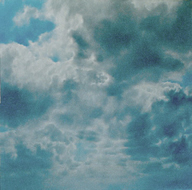
His paintings were part of modern art movements such as Fundamental Painting (the identity of the medium: surface, paint and texture are more important than the image) and Hyperrealism (in which the image is depicted even more sharply than a photograph). Grotenbreg sometimes even uses photography as a means to his ends.
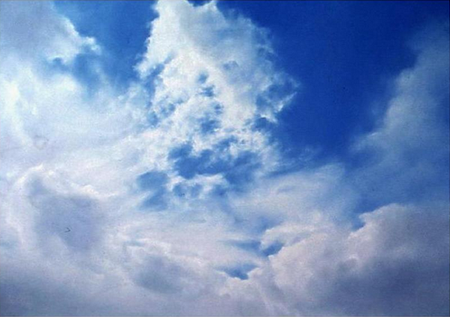
In 1996 Grotenbreg painted an indigo blue sky. A silvery full moon appeared in the nocturnal light. The atmosphere is arcane, occult. He went on to make a series of Moon Landscapes and Moons and Nocturnal Light. (This series was conceived on a tour of French villages, where the street lighting was turned off at night). At a particular moment in the series a dog appears in the paintings, as 'watch dog' between the sublunary and the translunary. In these paintings the mystical aspect in his work can be strongly felt.
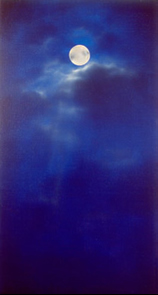
In 2000, Grotenbreg added another, more earthy, dimension to his work. He began to experiment with cement on canvas, as a rough ground for an image. Using this technique he made the painting Half Moon with a frame of cement. The result has often been compared to mediaeval mural painting, called fresco, painted in wet plaster.
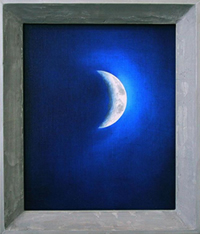
In Europe, especially in Italy (hence the name) this technique used to be a widespread decorative art form, of which only the weathered remains are left. Grotenbreg, however, is not so much interested in the images as such, but rather in the weather-beaten quality of them. This set off a major series of animal studies from nature.
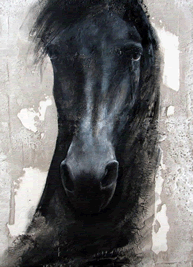
Animals such as horses, cows and bulls and lesser known animals, such as the black vulture (a protected bird of prey), the Egyptian ibis, bird of the Nile, as well as our own endangered sparrow are depicted by Grotenbreg on a ground of grey cement on canvas in shades of black and brown acrylics. He only paints animals he feels a certain affinity with. One of his favourites is the ibis, the Ibis as a god, the sacred bird of ancient Egypt. He made several journeys to Egypt.
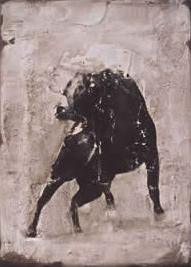
Grotenbreg about his method: "The cement ground on canvas is unique. This technique is highly unusual. Cement, after all, is a building material and doesn't stick to canvas. After a lot of trial and error I hit upon a good mixture with modern materials and solved the problem. The texture and composition of the cement are essential in these paintings, and experience is - as always - the master."
Jan Grotenbreg had several books about his work published:
- Plougrescant (Bretagne)
- The Moon
- Haka, the Jackdaw
- The Ibis
- Works on cement
- Birds
- Portraits
- Skyscapes
- Drawings and Pastels
- Bulls and Bisons
- Horses
- Cranes

BIOGRAFÍA
Jan Grotenbreg nació en la ciudad de Alkmaar, en el norte de Holanda, y estudiaba en la Academia de Bellas Artes Tilburg. Desde 1967, ha vivido en Ámsterdam en el último piso de un edificio de los años treinta, especialmente diseñado para artistas plásticas.
En 1970, Grotenbreg decidió pintar una superficie azul monocromática. Quería expresar el espacio total dentro del límite de tamaño. Desde esta perspectiva, comenzó a pintar cielos nublados, sin horizonte. Se puede ver estas pinturas como una continuación de la tradición de los pintores de paisajes holandeses del siglo 17. Las nubes de Grotenbreg son vistas como "evocaciones poderosas de la experiencia de recostarse sobre su espalda, masticando una brizna de hierba y contemplando el interminable, lento, teatral juego de nubes" (el crítico de arte Ferd Op de Coul). La elusividad y la naturalidad de las nubes, junto con los hermosos tonos de gris, le daba la inspiración.

Sus pinturas formaban parte de las tendencias histórico-artísticas modernas, como la fundamental painting (la superficie, la pintura y la textura son más importantes que la representación) y el hyperrealism (vea por ejemplo las obras de Duane Hanson).

En 1996, Grotenbreg pintó una superficie azul índigo, el cielo, una luna plateada y llena aparece en una misteriosa atmósfera oculta. Luego hizo una serie de paisajes lunares, lunas y luz nocturna (esta serie se creó durante un viaje a pueblos en Francia, donde las luces de la calle se apagaban por la noche). En cierto momento apareció también un perro, como un perro guardián, entre la sub-luna y la super-luna. En esta serie de obras el aspecto místico se hace tangible en su obra.

En el 2000, Grotenbreg agregó una nueva dimensión a su trabajo, cuando comenzó a experimentar con el cemento como fondo. De esta manera realizó el cuadro Half Moon. El resultado se compara a menudo con los murales medievales, el fresco, pintado en cal húmeda. Esto constituye el punto de partida para una impresionante serie de estudios animales en la naturaleza. Muchos animales, como el caballo, la vaca y el toro, así como animales menos conocidos como el ave de presa protegida, el buitre monje, el ave egipcia del Nilo Ibis y el gorrión, han sido depositados en una capa de cemento gris con pintura acrílica en matices de color marrón oscuro. Sólo pinta animales con los que tiene cierta afinidad. (El ibis, el ave sagrada en el antiguo Egipto, lo inspira en particular; hizo varios viajes a Egipto).
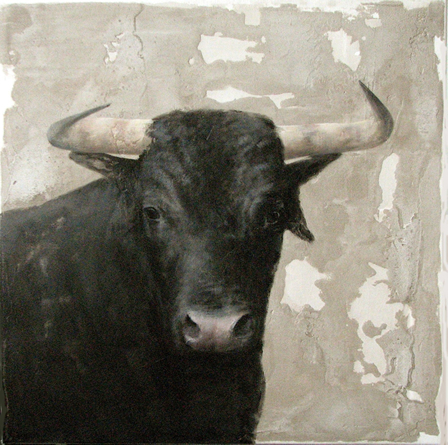
Grotenbreg sobre esa técnica: "El sustrato con cemento es único, la técnica no es común. El cemento es un material de construcción y no se adhiere al lienzo. Después de muchos experimentos, he encontrado una solución a este problema con los aglutinantes modernos. La textura y la composición del cemento que aplico es una parte importante de mi trabajo: la experiencia es el maestro".

Jan Grotenbreg ha publicado varios libros sobre su arte: Plougrescant (Bretagne); La Luna Haka, el Jackdaw, El ibis, Trabajando sobre cemento. En 1979 recibió la medalla de bronce en el Premio Europa de Pintura en Ostende y en 1991 el Primer Premio en el Museo Bíblico de Ámsterdam. Su obra está representado en los Estados Unidos por Broschofsky Galleries, Ketchum, Idaho.
